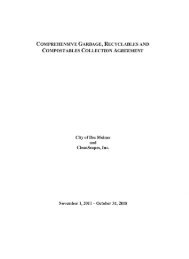CITY OF DES MOINES SHORELINE MASTER PROGRAM
CITY OF DES MOINES SHORELINE MASTER PROGRAM
CITY OF DES MOINES SHORELINE MASTER PROGRAM
Create successful ePaper yourself
Turn your PDF publications into a flip-book with our unique Google optimized e-Paper software.
Des Moines Shoreline Inventory and Characterization<br />
Flood Hazard Areas<br />
Flood hazard areas are not defined in the DMMC. However, they are typically defined as those<br />
areas that are determined to be at risk of having a one percent or greater chance of experiencing a<br />
flood in any one year. These areas are typically identified on the Federal Emergency<br />
Management Agency (FEMA) flood insurance rate maps as the 100-year floodplain.<br />
All coastal beaches within the City’s jurisdiction are included within the 100-year floodplain<br />
(King County, 2002). Low areas along the corridors of the Des Moines and Massey Creeks<br />
within the jurisdiction are also designated as lying within the 100-year floodplain. The King<br />
County Sensitive Areas Map Folio (King County, 1990) shows the beach areas within the<br />
jurisdiction and the low area at the mouth of McSorley Creek as lying within the 100-year<br />
floodplain. Frequently flooded areas are indicated on Figure 13.<br />
Shoreline Modifications<br />
Shoreline modification refers to structural changes to the shorelines’ natural bank. Examples<br />
include shoreline armoring (bulkheads, rip-rap, etc.), overwater structures (dock and piers), or<br />
dredging and filling. The following assessment of the extent of shoreline modification is<br />
primarily based on review of 2001 oblique and 2002 vertical aerial photos. . A field visit on<br />
October 6, 2004 was also used to verify the reported shoreline modifications in areas that were<br />
accessible.<br />
Dredging<br />
The City does not maintain a regular schedule for dredging the Des Moines Marina. Dredging<br />
has occurred twice in the past 25 years. In 1983 approximately 6,912 cubic yards of material<br />
was removed from the marina and disposed at an approved site in Commencement Bay. In 1994,<br />
approximately 5,616 cubic yards were removed and disposed at an approved site in<br />
Commencement Bay (Dusenbury, personal communication, 2005).<br />
Shoreline Armoring<br />
The term shoreline armoring often refers to bulkheads and seawalls. However it can also, more<br />
broadly, include the placement of structures in the nearshore in an attempt to intercept wave<br />
energy and/or control the movement of sediment (KCDNR, 2001). Shoreline armoring is<br />
typically used to protect upland property from wave induced erosion, to retain or stabilize<br />
unstable banks, or to create areas of calm water, stabilize entrances to harbors, or establish<br />
moorage for vessels. However, shoreline armoring also has the adverse effects on the nearshore<br />
physical processes necessary to maintain native species habitats and shoreline functions. These<br />
effects include the loss of beach areas, impoundment of sediment, modification of groundwater<br />
regimes, lowering of beach elevations, redirection of wave energy, alteration of substrate, and<br />
loss of riparian vegetation and associated functions (KCDNR, 2001; MacDonald et al, 1994).<br />
The increase in population in the Puget Sound area in recent years has resulted in the armoring of<br />
more than 29 percent of the Puget Sound’s shoreline. According to the Washington State<br />
Department of Natural Resources ShoreZone Inventory (2001), approximately 64 percent of<br />
WRIA 9 (this includes the Green/Duwamish river systems) is armored and 87 percent of the<br />
March 2005 Page 27



